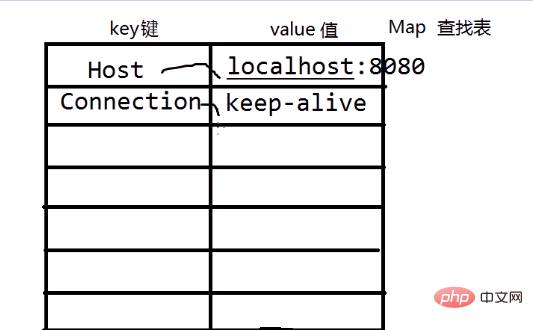Basic usage of Java Map

##Java Map Interface (Recommended learning: java course)

java.util.Map interface lookup table
Map 体现的结构是一个多行两列的表格,左列称为key 右列称为value. Map 总是根据key来获取对应的value.因此保存数据时是成对保存的,并且应当将查询的数据作为value查询条件作为key进行保存. Map要求key 不允许重复(equals 比较判定)
Commonly used implementation classes
java.util.HashMap, hash table , Hash tableThe fastest data structure to queryBasic usage
public class MapDemo{
public static void main(String[] args){
Map<String,Integer>map = new HashMap<>();
/*
* V put(K k,V v)
* 将给定的key-value对存入Map
* 由于Map要求key不允许重复,所以若
* 使用重复的key存储则是替换value操作
* 那么返回值就是该key原来对应的value
* 若给定的key不存在则返回值为null.
*/
map.put("攻击",60);
Integer value=map.put("攻速",8);
System.out.println(value); // null
value=map.put("攻速",6);
System.out.println(value); // 8
/*
* V get(Object key)
* 根据给定的key获取对应的value
* 若给定的key不存在则返回值为null
*/
value =map.get("攻击");
System.out.println(value);//60
/*
* V remove(Object key)
* 删除当前Map中给定的key所对应的键值对
* 返回值为该key对应的value
*/
value = map.remove("攻击");
System.out.println(map);
System.out.println(value);
/*
* int size()
* 返回Map中的元素个数
*/
int size = map.size();
System.out.println(size);
/*
* 判断当前Map是否包含给定的key或value
*/
boolean ck = map.containsKey("攻速");
System.out.println("包含key:"+ck);
boolean cv = map.containsValue(96);
System.out.println("包含value:"+cv);
}
}Map traversal
import java.util.HashMap;
import java.util.Map;
import java.util.Map.Entry;
import java.util.Set;
/**
* Map的遍历 Map提供了三种遍历方式: 1:遍历所有的key 2:遍历每一组键值对 3:遍历所有的value(相对不常用)
*
*/
public class MapDemo2 {
public static void main(String[] args) {
Map<String, Integer> map
= new HashMap<>();
map.put("语文", 99);
map.put("数学", 98);
map.put("英语", 97);
map.put("物理", 96);
map.put("化学", 99);
System.out.println(map);
/*
* 遍历所有的key
* Set keySet()
* 将当前Map中所有的key以一个Set集合
* 形式返回.遍历该集合等同于遍历了所有
* 的key
*/
Set<String> keySet = map.keySet();
for(String key : keySet) {
System.out.println("key:"+key);
}
/*
* 遍历每一组键值对
* Set entrySet()
* 将当前Map中每一组键值对以一个Entry实例
* 存入Set集合并返回.
*
* java.util.Map.Entry
* Entry的每一个实例用于表示Map中的一组
* 键值对
*/
Set<Entry<String,Integer>> entrySet
= map.entrySet();
for(Entry<String,Integer> e:entrySet) {
String key = e.getKey();
Integer value = e.getValue();
System.out.println(key+":"+value);
}
}
}The above is the detailed content of Basic usage of Java Map. For more information, please follow other related articles on the PHP Chinese website!

Hot AI Tools

Undresser.AI Undress
AI-powered app for creating realistic nude photos

AI Clothes Remover
Online AI tool for removing clothes from photos.

Undress AI Tool
Undress images for free

Clothoff.io
AI clothes remover

AI Hentai Generator
Generate AI Hentai for free.

Hot Article

Hot Tools

Notepad++7.3.1
Easy-to-use and free code editor

SublimeText3 Chinese version
Chinese version, very easy to use

Zend Studio 13.0.1
Powerful PHP integrated development environment

Dreamweaver CS6
Visual web development tools

SublimeText3 Mac version
God-level code editing software (SublimeText3)

Hot Topics
 1378
1378
 52
52
 Perfect Number in Java
Aug 30, 2024 pm 04:28 PM
Perfect Number in Java
Aug 30, 2024 pm 04:28 PM
Guide to Perfect Number in Java. Here we discuss the Definition, How to check Perfect number in Java?, examples with code implementation.
 Random Number Generator in Java
Aug 30, 2024 pm 04:27 PM
Random Number Generator in Java
Aug 30, 2024 pm 04:27 PM
Guide to Random Number Generator in Java. Here we discuss Functions in Java with examples and two different Generators with ther examples.
 Weka in Java
Aug 30, 2024 pm 04:28 PM
Weka in Java
Aug 30, 2024 pm 04:28 PM
Guide to Weka in Java. Here we discuss the Introduction, how to use weka java, the type of platform, and advantages with examples.
 Smith Number in Java
Aug 30, 2024 pm 04:28 PM
Smith Number in Java
Aug 30, 2024 pm 04:28 PM
Guide to Smith Number in Java. Here we discuss the Definition, How to check smith number in Java? example with code implementation.
 Java Spring Interview Questions
Aug 30, 2024 pm 04:29 PM
Java Spring Interview Questions
Aug 30, 2024 pm 04:29 PM
In this article, we have kept the most asked Java Spring Interview Questions with their detailed answers. So that you can crack the interview.
 Break or return from Java 8 stream forEach?
Feb 07, 2025 pm 12:09 PM
Break or return from Java 8 stream forEach?
Feb 07, 2025 pm 12:09 PM
Java 8 introduces the Stream API, providing a powerful and expressive way to process data collections. However, a common question when using Stream is: How to break or return from a forEach operation? Traditional loops allow for early interruption or return, but Stream's forEach method does not directly support this method. This article will explain the reasons and explore alternative methods for implementing premature termination in Stream processing systems. Further reading: Java Stream API improvements Understand Stream forEach The forEach method is a terminal operation that performs one operation on each element in the Stream. Its design intention is
 TimeStamp to Date in Java
Aug 30, 2024 pm 04:28 PM
TimeStamp to Date in Java
Aug 30, 2024 pm 04:28 PM
Guide to TimeStamp to Date in Java. Here we also discuss the introduction and how to convert timestamp to date in java along with examples.
 Java Program to Find the Volume of Capsule
Feb 07, 2025 am 11:37 AM
Java Program to Find the Volume of Capsule
Feb 07, 2025 am 11:37 AM
Capsules are three-dimensional geometric figures, composed of a cylinder and a hemisphere at both ends. The volume of the capsule can be calculated by adding the volume of the cylinder and the volume of the hemisphere at both ends. This tutorial will discuss how to calculate the volume of a given capsule in Java using different methods. Capsule volume formula The formula for capsule volume is as follows: Capsule volume = Cylindrical volume Volume Two hemisphere volume in, r: The radius of the hemisphere. h: The height of the cylinder (excluding the hemisphere). Example 1 enter Radius = 5 units Height = 10 units Output Volume = 1570.8 cubic units explain Calculate volume using formula: Volume = π × r2 × h (4




